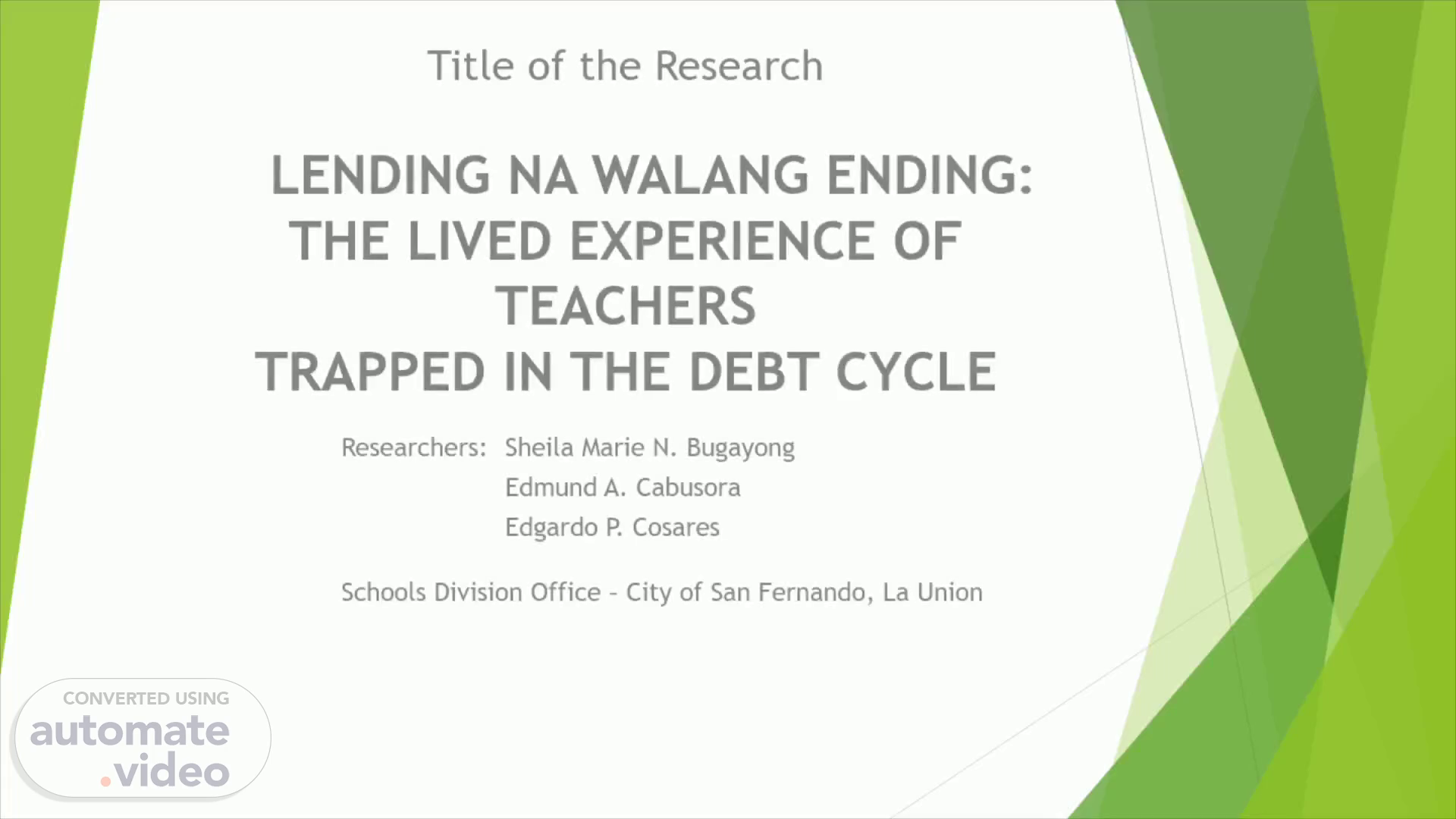
Page 1 (0s)
[Audio] Title of the Research: LENDING NA WALANG ENDING: THE LIVED EXPERIENCE OF TEACHERS TRAPPED IN THE DEBT CYCLE Researchers: Sheila Marie N. Bugayong, Edmund A. Cabusora, and Edgardo P. Cosares Schools Division Office – City of San Fernando, La Union.
Page 2 (25s)
[Audio] Introduction The financial and economic challenges encountered by teachers pushed them to borrow incessantly to augment their income. Financial lending institutions, either from the government, state-run corporations, and that of the private entities, have provided the needed loans of teachers for them to survive the economic challenges of daily life. The scenario of borrowing is not new to DepEd personnel. In an article written by Cruz (2019), it identified DepEd personnel with the largest borrowing with a whopping 319 Billion from government lending entities and 162 Billion from private lending institutions During informal conferences and gatherings, personnel lament of the financial status they have. They claim that their take home pay would barely meet for the next pay day. This is one of the reasons that they resort to borrowing in order to augment their monthly earnings. Despite the aggressive financial training and seminars of DepEd, the problem still lingers as teachers engage in multiple loans to make both ends meet With this, the study explored the lived experiences of teachers trapped in the debt cycle, for the School Year 2021-2022, as a basis for a validated financial literacy wellness package.
Page 3 (1m 51s)
[Audio] Research Question The study explored the lived experiences of teachers trapped in the debt cycle as a basis in the formulation of a financial wellness package. Specifically, it sought answers to the following queries: What are the lived experiences of the participants? What are their coping mechanisms? What validated financial wellness package can be proposed?.
Page 4 (2m 20s)
[Audio] Methodology Research Design. The study used the qualitative approach particularly Husserl's Phenomenological Interpretative Design. The participants related their experiences, in relation to their debt situation they have; thus, interpretations were made leading to the formulation of thematic images Participants. Ten informants were identified based from the Saturation Principle Instrumentation. A validated interview guide served as the main data gathering tool. Data Analysis. The lived experiences of the participants were analyzed with the procedures of extraction, and saturation and formulation of images. The Collaizzi's method further guided the data analysis. Confidentiality and the Principle of Privacy were strictly observed to protect the respondents of the study..
Page 5 (3m 24s)
[Audio] Intervention The output which is the financial wellness package model is similar to a human resource development intervention. The parts of the intervention were as follows: rationale, general objectives, and a three phase implementation cycle (pre- implementation, implementation proper, and post implementation)..
Page 6 (3m 49s)
[Audio] Result and Discussion Emerged themes were: Surviving Roller Coaster Ride, Carrying the Burden, Living with the Anguish, My family, my refuge, My faith to a Supreme Being, and My body and mind connection. The financial model was valid with an over-all mean of 4.00 which implies that it is suitable and functional to address the peculiar concerns of the study. They study reflected the lived experiences and coping mechanisms of the teachers. In addition, it portrayed their debt conditions as they affect the lived experiences of the teachers and their support system. Indeed, the findings confirm that the seeming "endless debts" remain a gargantuan challenge to the financial well-being of teachers. The lived experiences of the informants reflect, in varying degrees, their emotional, physical, social challenges given their financial struggles. The financial wellness package model is recommended for adoption by the SDO..
Page 7 (4m 57s)
[Audio] Implementation and Extent of Utilization Used the "Pagiwarnak" SDO Newsletter and Bamboo Research Journal of the SDO as dissemination of the study Conduct of the LAC of schools in relation to the study conducted Conduct of FDGs.
Page 8 (5m 19s)
[Audio] Pictures and other Documentations The research proponents, during their sharing of insights to professionals and teachers' gatherings, relative to financial wellness and literacy..